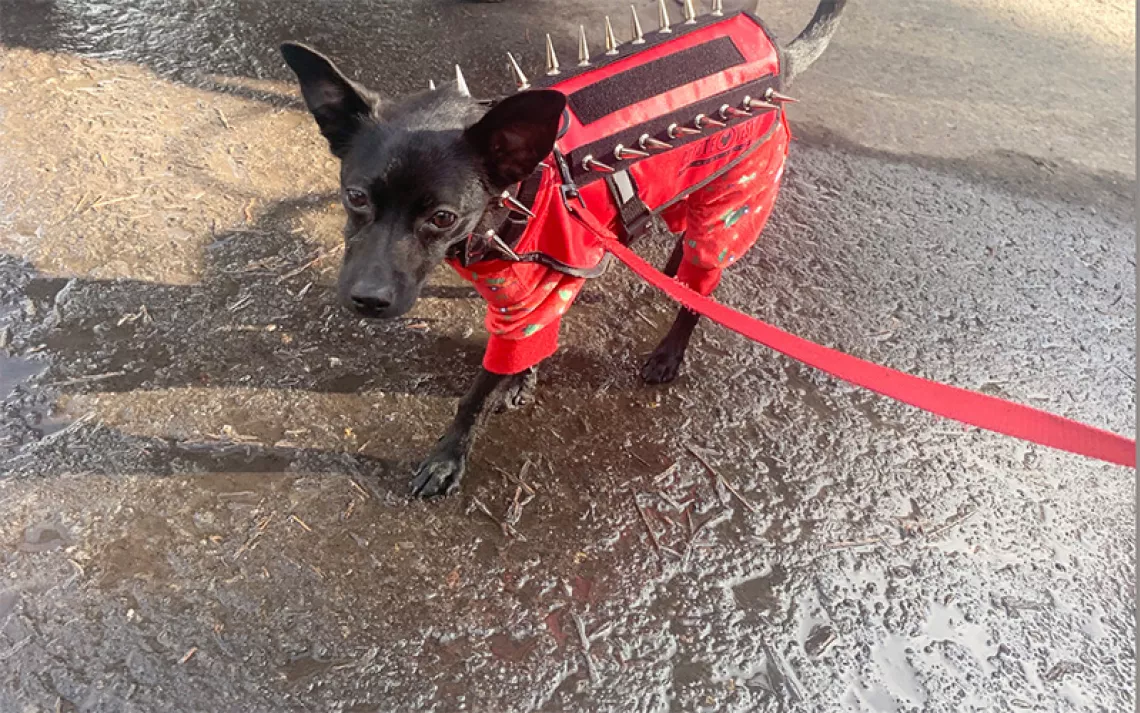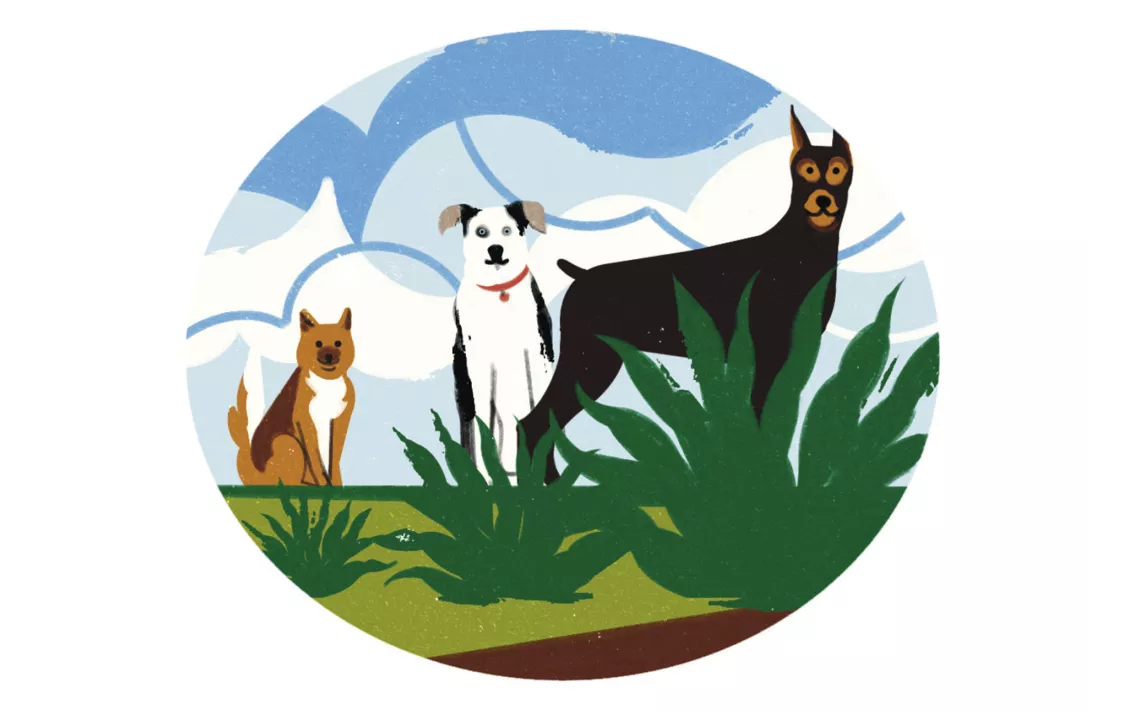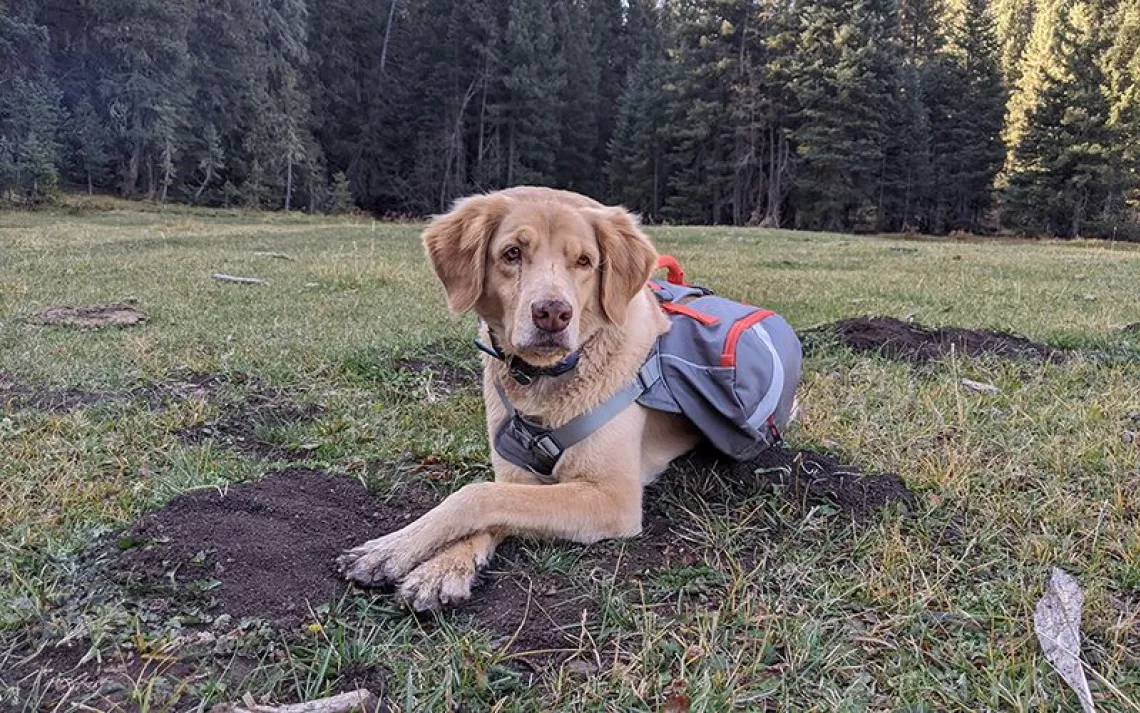Conservation Dogs Sniff Out Endangered Species
Sit. Stay. Track.
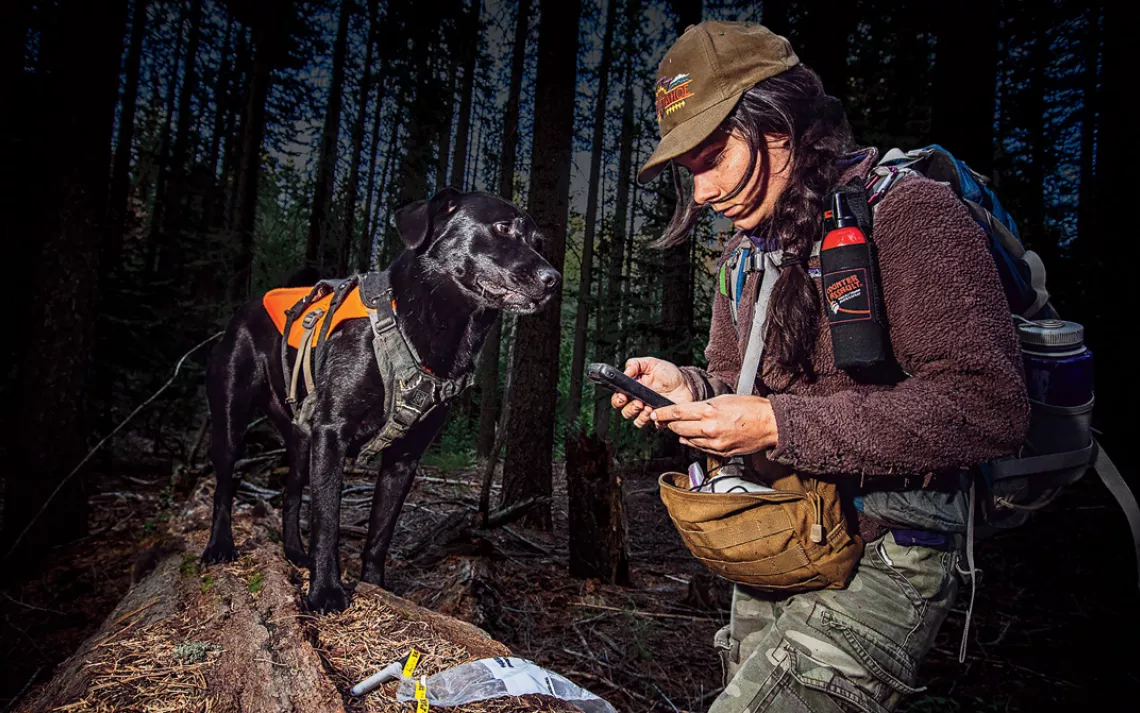
Winnie, one of CK9's sniffer dogs, looks on as handler Jennifer Hartman logs data for fisher scat. | Photo by Morgan Heim
ON A CRISP SEPTEMBER afternoon just outside of Banff National Park, Canada, an 11-year-old black Labrador named Sampson weaves through the dense forest, scooting under shrubbery and hopping over mossy logs. Suddenly his wandering straightens out and his tail begins to spin in circles.
"Whaddya got?" asks Julianne Ubigau, a handler with the detection-dog program Conservation Canines (CK9), part of the University of Washington's Center for Conservation Biology. Sampson, one of about 17 CK9 dogs, stops with his nose pointing at what looks like a pile of half-cooked bran muffins. Ubigau kneels next to the pile of fresh bear scat and holds up a palm. "Sit. Stay."
Sampson quivers with excitement as Ubigau pulls a red ball from her bulging backpack. With one hand she tosses the ball sidearm to Sampson, who lunges at it in a paroxysm of joy. With the other, she starts to enter a long list of data about the sample into a smartphone, including what animal left the pile and how old it is. She takes a GPS reading and a photograph. Every few seconds, Sampson shoves the ball back toward her, snorting with delight.
A dog's nose is one of the most sensitive instruments in the animal kingdom, able to identify melanoma cells and find illegal drugs hidden inside gas tanks. The CK9 dogs have a more mundane but equally important talent that's being put to use for scientific studies around the world: sniffing out the poop of endangered species.
The idea came to CK9 program director Samuel Wasser in 1997, when he was studying baboons and elephants in Tanzania. He and other researchers were learning to extract hormones and DNA from animal scat. Dogs, he realized, were perfectly suited to locating samples over large landscapes.
Wasser, a lifelong dog owner, admits that the idea of using dogs didn't occur to him right away. When it did, he realized that he'd need something other than traditional nose-to-the-ground tracking dogs, which are trained to follow trails, not to locate discrete objects. "You need an air-scent dog, like a drug dog," he says. With the help of a master canine trainer from the Washington State Department of Corrections, Wasser found a training course for narcotics-detection dogs and went through it, starting with pot, then switching to scat.
Wasser's first scat study using dogs, a two-week outing near Goat Peak in Washington's North Cascades in 1998, didn't turn up many samples, but one of them was the first grizzly bear scat found in the state in modern times. "You could see, wow, this could really work," he says. The next year, a larger study in Canada's Jasper National Park located 30 grizzly samples in one day, and the project was off and running.
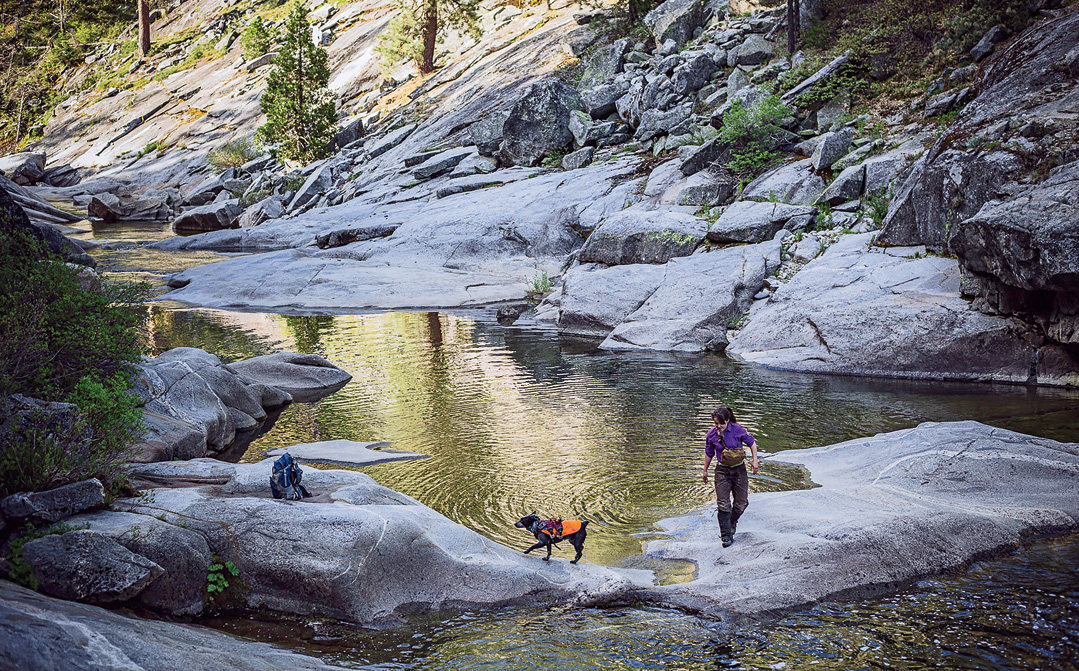
Pips and his handler, Suzie Marlow, investigate a Sierra river crossing while surveying for rare Pacific fishers. | Photo by Morgan Heim
A DOG'S SENSE OF SMELL is so far beyond ours, it's almost a different sense entirely. Dog brains have about 50 times more olfactory receptors; one study estimated that dogs can smell 10,000 times better than humans can, the equivalent of being able to taste a teaspoon of sugar in a million gallons of water. Trained CK9 dogs can detect moose scat buried deep in snow and find pocket mouse droppings the size of a grain of rice in an area the size of a football field.
Animal scat provides a wealth of biological information. Its location lets researchers estimate how many animals there are and how they're distributed over the landscape. Genetic tests can identify individual animals, while hormone-level testing shows if they're stressed or pregnant. Toxicology tests reveal if they're being poisoned.
"Every target scat is like gold to a researcher," says handler Jennifer Hartman of the University of Washington. "Missing just one sample, especially in an area with low species abundance, means that a particular target species may not get counted."
Scat sampling is also more statistically random and much less intrusive than traditional sampling methods like capturing animals for radio collaring or tagging, Wasser says. Researchers can track multiple species at the same time across large, remote areas and repeat the surveys over different seasons and years.
In fact, no other wildlife sampling method can acquire so much information in so short a time, Wasser says. "It lets you collect a huge amount of data without ever disturbing the environment."
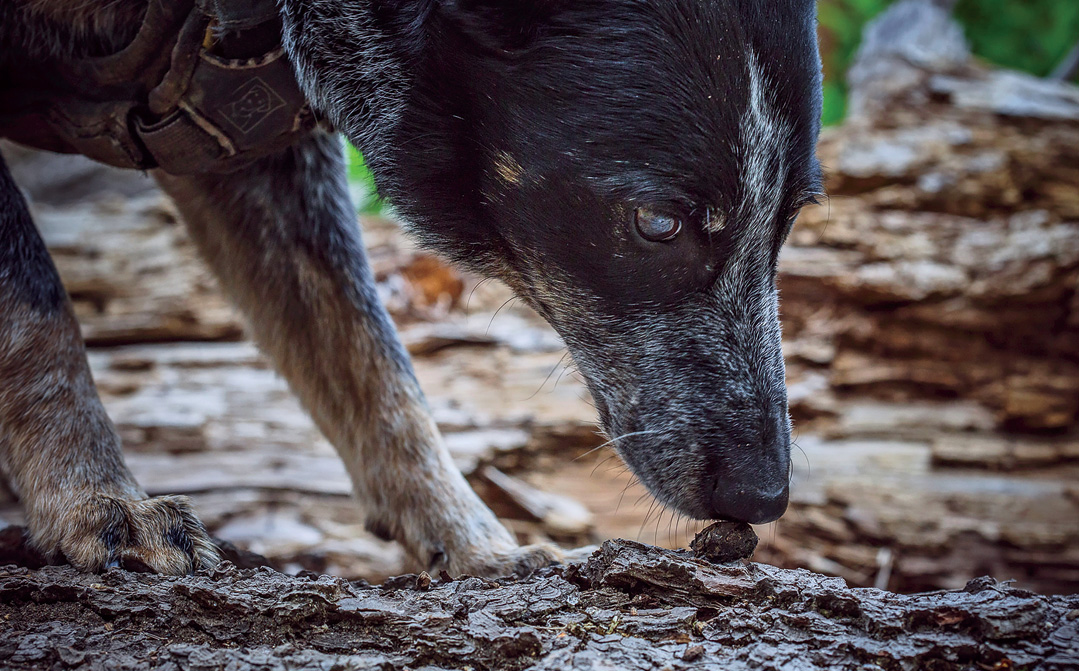
Max demonstrates his olfactory skills at a training session in the Sierra Nevada. | Photo by Morgan Heim
"GET YOUR BALL!" Ubigau says to Sampson, tossing it again and again as she enters data into her phone. The dog's intensity is almost unnerving. After a few minutes, she finishes and stands up. "Attaboy," she says. "Good search. Let's go." Sampson bounds off into the woods.
We started our trek in a rocky drainage that had been scoured by floods in 2013. Now we're climbing steep hillsides choked with brush and fallen trees. Sometimes our route follows faint game trails, but mostly this is raw Rocky Mountain bushwhacking.
Sampson ranges in all directions but never goes out of earshot. He finds half a dozen samples over the next few hours: more bear, some lynx, one that might be coyote or wolf. Ubigau collects some samples in ziplock bags and pokes others with a toothpick for DNA analysis.
Eventually, Sampson leads us to an open slope at 6,000 feet. Two days ago it was dumping snow, but now the sun is out and all three of us are panting. Our route will take us in a rough circle through a five-square-kilometer chunk of mountains. It's one of 48 cells that make up the entire study area, part of a master's research project led by Eric Spilker of the University of Alberta. He's looking at the ranges of seven species of carnivore—black bear, grizzly bear, lynx, wolf, bobcat, coyote, and cougar—to see where they overlap and how they use resources in this rugged terrain.
We take a breather near the top of the mountain and soak up the view of the serrations that form this part of the Northern Rockies. Ubigau fills a water bowl for Sampson and pulls out an energy bar for herself.
Sampson, she says, was rescued from the Seattle Humane Society and has since been trained on more than a dozen species, from salamanders to wolverines. His goal, for any target animal, is always the same: Find the scat and get the ball, over and over, day after day. As long as that equation holds, he thinks it's all one big game. "We want to keep the job as fun for them as possible," Ubigau says. "And Sampson is definitely one of the more manic dogs in the program."
That's part of the point. CK9 dogs have to be "insanely obsessive" about playing fetch, Wasser says. "Our dogs love balls more than anything—you could throw a ball next to a steak and the dog will go after the ball."
Like Sampson, almost all the CK9 dogs come from shelters, where they are often considered unadoptable because of their high energy and fanatical fixation on play, and the destructive behavior that can go along with it. "They drive their owners absolutely crazy," Wasser says.
The researchers who work with these animals all have stories of their astonishing focus. There's Sadie, now retired, whose owner put a ball on top of the refrigerator and came back nine hours later to find her still staring up at it. Another dog, working in Africa, sat by a pile of cheetah scat as a herd of gazelles stampeded around him. In Brazil, a dog named Gator was sitting next to a sample when he started hopping to one side, a few feet at a time. It turned out the tiny bit of scat he had found was being carried away by leaf-cutter ants.
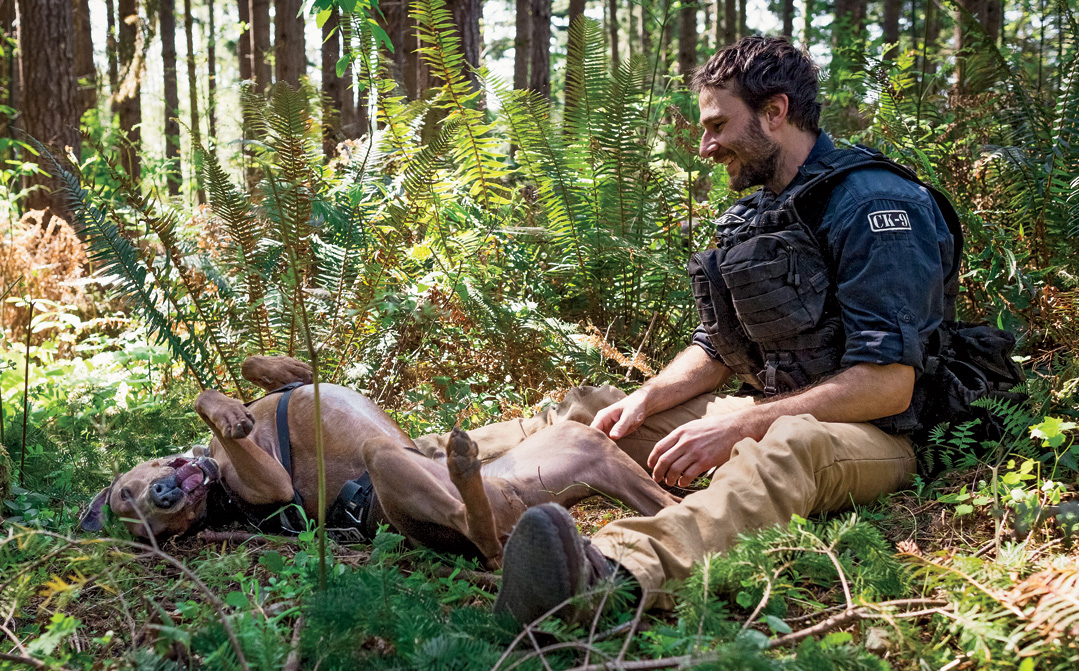
Caleb Stanek relaxes with Captain, whose endless energy makes him an unsuccessful pet but an excellent conservation dog. | Photo by Jaymi Heimbuch
Heath Smith, Conservation Canines' program coordinator and head trainer, likens this kind of personality to a form of canine OCD that makes the dogs ideally suited to CK9 work. "They are the misfits of the pet world," he says, "but when they make it into our program, they become the heroes of the conservation world."
Only about 5 percent of the dogs tested at the shelters make the initial cut. Retrievers and Labs make good detection dogs, along with border collies and Australian cattle dogs. Jack Russells work well for tracking smaller animals. After identifying potential candidates, CK9 trainers bring them to the program's housing and training facility in Eatonville, Washington, just south of Tacoma. There are large, fenced-off outdoor runs behind the main building and endless trails through 4,300 acres of forestland. Dogs train on frozen samples and are judged more on sheer motivation than on a great sense of smell. "You can train any dog to do this work," Smith says, "but you can't train any dog to sustain it all day long." Two years old is an ideal age at which to start, and the average career lasts about 10 years.
"We don't overtrain them on obedience," Ubigau says. "We want to keep that wildness that makes them good in the field." It's also important that the dogs don't have the inclination to chase after animals they might meet. About 90 percent of the dogs that make it to the center end up graduating into the program, and the training can take as little as a few weeks. Handlers are another story. "Training dogs is nothing compared to training handlers," Smith says. They need the confidence and ability to read the dogs' subtle behavioral signs, and the patience to deal with such high-strung animals day after day. They travel year-round, constantly moving from one study site to another, working with different dogs and coworkers at each location. "Being a handler is more of a lifestyle than a job," Ubigau says.
"Most applicants see this as a romantic job of wandering the national parks of the world with a dog, when in fact it's 16-hour days with very little downtime and the unrelenting stress of having to be successful," Smith says. "We push applicants to the limits to see how they are going to treat the dogs once they have been camping in 100-degree heat for a month with little sleep, no shower, no Internet, and no TV."
Only about 20 percent to 25 percent of prospective handlers make it through training, which takes about two months. Then they're ready to work on projects that might involve cougars in the Great Basin or bats in Alaska.
One of the biggest challenges for researchers who want to hire CK9 teams is the cost: roughly $45 per hour for a dog and handler, plus travel costs. But considering how much information a dog survey can gather, compared with how much it would cost to get the data in other ways, it's a bargain. "A lot of people don't really appreciate the power of this tool," Wasser says.
Craig Thompson, a wildlife ecologist with the U.S. Forest Service, has used CK9 teams for seven years to monitor fishers—a large member of the weasel family—amid the steep forests and illegal pot farms of the Sierra Nevada. "Their ability to locate signs of an animal's presence in an area is far superior to other noninvasive monitoring techniques," he says. They can't provide the detailed movement data that radio telemetry can, and they can't be left out for six months like some of the newer motion cameras can. But as long as you're realistic about what a CK9 team can do, he says, "they are the most effective and efficient research tool I've ever used."
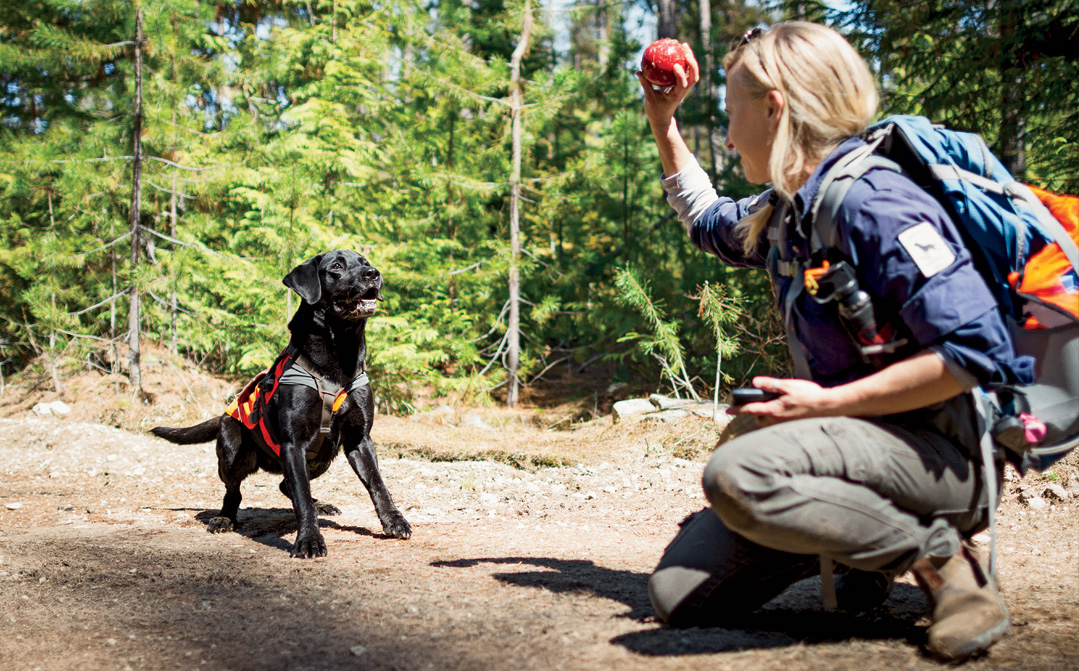
Sampson waits for Julianne Ubigau to throw the ball, his reward for finding bobcat scat. | Photo by Jaymi Heimbuch
THE LARGEST CK9 PROJECT to date was a study in the tar sands region of northeast Alberta, Canada, between 2006 and 2013. It was funded by Statoil, the Norwegian state oil company, which had a multibillion-dollar project in the area. At the time, the Canadian government was proposing to kill up to 80 percent of area wolves to stem a drop in the caribou population; the study was meant to determine whether wolves—or the presence of humans—were to blame for that decline.
Petroleum activity is concentrated in the winter, when large vehicles can move around on frozen roads, so that's when the surveys had to take place. Over four field seasons, up to seven pairs of CK9 dogs and handlers plowed through eight-foot-deep snow, eventually accumulating more than 4,000 scat samples. Analyses of the scat showed that the oil work was having an impact: Stress hormones were higher around people, and the caribou weren't eating enough lichen, their main winter food. (The study also showed that there were probably more than twice as many caribou in the area as previously estimated.) Instead of shooting wolves, the study concluded, the best strategy to help the caribou recover would be to restrict human activity where lichen was plentiful. As for killing wolves, that could have made things worse by encouraging deer to move in and compete with the caribou.
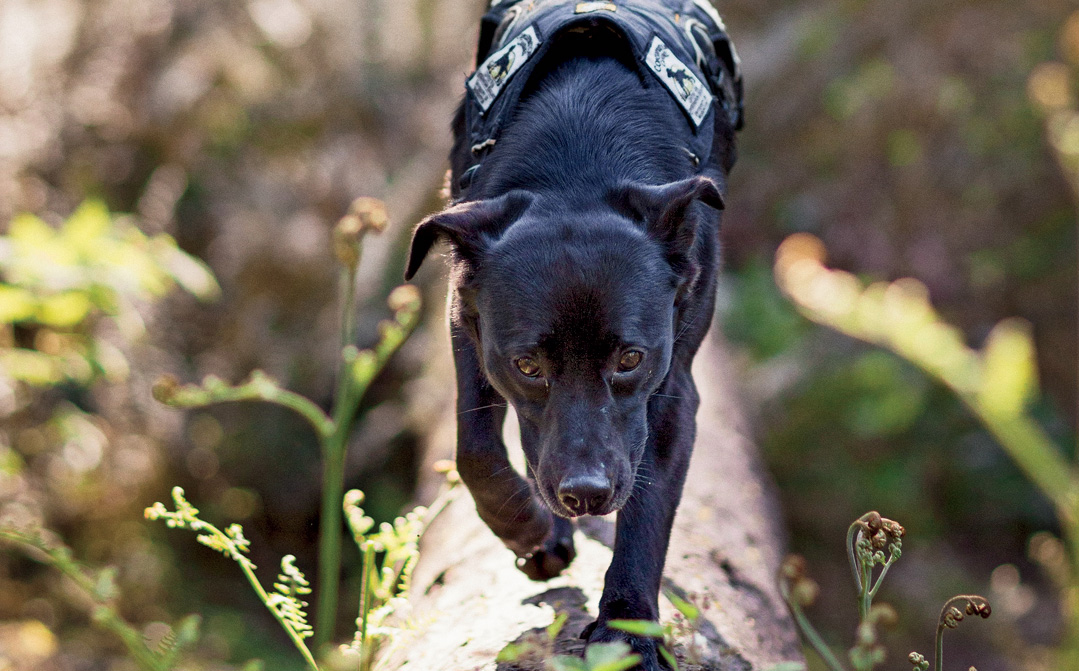
Winnie tracks fisher scent along a fallen tree. | Photo by Jaymi Heimbuch
BACK NEAR BANFF, it's 8 P.M. by the time we finish our loop: 7.7 miles in all, according to the GPS tracker on Sampson's collar. He's found 16 samples, about average for a workday, maybe a little below, says Ubigau. We slog down a steep, muddy trail as the light slowly fades.
As we hop from one mossy hummock to the next, Ubigau talks about how she plans to expand the education-outreach part of the CK9 program. Kids love dogs, she says, so bringing the animals into schools is a great way to educate locals about what the research teams are doing. One study that started in May, for example, has been looking at how wolf recovery in northeast Washington has affected prey species and other carnivores. Considering the typical rural opposition to wolves, the recovery effort has been embraced by residents to a surprising degree, in part because of outreach programs in schools.
In 2015, CK9 teams were sent to the Pyrenees and Turkey, where a study is looking at the distribution of wolves, lynx, brown bears, badgers, stone martens, pine martens, wild boars, roe deer, and wild cats. As successful as their program has been, Smith and Wasser are always looking to expand its scope. They just finished training dogs to find the scat, or "frass," of the endangered silverspot caterpillar on Mount Hebo, Oregon. ("A shocking success," Smith says.) CK9 dogs are already sniffing orca scat from boats in the Puget Sound in order to track whale health, and helping to show the impacts of human activity on bears in the Canadian Rockies. Moving beyond scat, CK9 is also working to make the process of counting bird and bat carcasses at wind farms more efficient and reliable.
The sun is setting by the time Ubigau and I wade across a milky glacial stream toward our waiting pickup truck. Sampson splashes across, looking as energetic as he did this morning. Everyone is happy: Sampson got the ball, and Ubigau collected her data. Mission accomplished.
This article appeared as "Sit. Stay. Track." in the January/February 2016 print edition of Sierra.
Watch
Watch Caleb Stanek and his conservation canine visit the Cape Perpetual Scenic Area to survey for bobcats and martens.
 The Magazine of The Sierra Club
The Magazine of The Sierra Club

